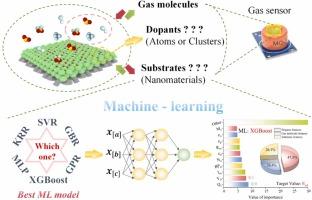A machine learning feature descriptor approach: Revealing potential adsorption mechanisms for SF6 decomposition product gas-sensitive materials
IF 12.2
1区 环境科学与生态学
Q1 ENGINEERING, ENVIRONMENTAL
引用次数: 0
Abstract
The man-made gas sulfur hexafluoride (SF6) is an excellent and stable insulating medium. However, some insulation defects can cause SF6 to decompose, threatening the safe operation of power grids. Based on this, it is of great significance to find and effectively control the decomposition products of SF6 in time. Gas sensors have proven to be an effective way to detect these decomposition gases (SO2, SOF2, SO2F2, H2S, and HF). Nanomaterials with gas-sensitive properties are at the heart of gas sensors. In recent years, data-driven machine learning (ML) has been widely used to predict material properties and discover new materials. However, it has become a major challenge to establish a common model between material properties derived from various types of calculations and intelligent algorithms. In order to make some progress in addressing this challenge. In this work, 250 data sets were extracted from 52 publications exploring the detection of SF6 decomposition products by nanocomposites based on relevant work over the past 10 years, and the adsorption behavior of SF6 decomposition products can be predictively analyzed. By comparing six different algorithmic models, the best model for predicting the adsorption distance (XGBoost: R2 = 91.94 %) and adsorption energy (GBR: R2 = 78.63 %) of SF6 decomposed gas was identified. Subsequently, the importance of each of the selected feature descriptors in predicting the gas adsorption effect was explained. This work combines first-principles computational results and machine-learning algorithms with each other to provide a new research idea for evaluating the gas sensing capability of nanocomposites.

机器学习特征描述方法:揭示 SF6 分解产物气敏材料的潜在吸附机制
人造气体六氟化硫(SF6)是一种优良而稳定的绝缘介质。然而,一些绝缘缺陷会导致 SF6 分解,威胁电网的安全运行。基于此,及时发现并有效控制 SF6 的分解产物具有重要意义。事实证明,气体传感器是检测这些分解气体(SO2、SOF2、SO2F2、H2S 和 HF)的有效方法。具有气敏特性的纳米材料是气体传感器的核心。近年来,数据驱动的机器学习(ML)被广泛用于预测材料特性和发现新材料。然而,如何在各类计算和智能算法得出的材料特性之间建立通用模型已成为一大挑战。为了在应对这一挑战方面取得一些进展。在这项工作中,根据过去 10 年的相关工作,从 52 篇探讨纳米复合材料检测 SF6 分解产物的论文中提取了 250 组数据,并对 SF6 分解产物的吸附行为进行了预测分析。通过比较六种不同的算法模型,确定了预测 SF6 分解气体吸附距离(XGBoost:R2 = 91.94 %)和吸附能量(GBR:R2 = 78.63 %)的最佳模型。随后,解释了所选特征描述符在预测气体吸附效果方面的重要性。这项工作将第一原理计算结果与机器学习算法相互结合,为评估纳米复合材料的气体传感能力提供了一种新的研究思路。
本文章由计算机程序翻译,如有差异,请以英文原文为准。
求助全文
约1分钟内获得全文
求助全文
来源期刊

Journal of Hazardous Materials
工程技术-工程:环境
CiteScore
25.40
自引率
5.90%
发文量
3059
审稿时长
58 days
期刊介绍:
The Journal of Hazardous Materials serves as a global platform for promoting cutting-edge research in the field of Environmental Science and Engineering. Our publication features a wide range of articles, including full-length research papers, review articles, and perspectives, with the aim of enhancing our understanding of the dangers and risks associated with various materials concerning public health and the environment. It is important to note that the term "environmental contaminants" refers specifically to substances that pose hazardous effects through contamination, while excluding those that do not have such impacts on the environment or human health. Moreover, we emphasize the distinction between wastes and hazardous materials in order to provide further clarity on the scope of the journal. We have a keen interest in exploring specific compounds and microbial agents that have adverse effects on the environment.
 求助内容:
求助内容: 应助结果提醒方式:
应助结果提醒方式:


